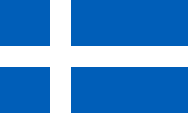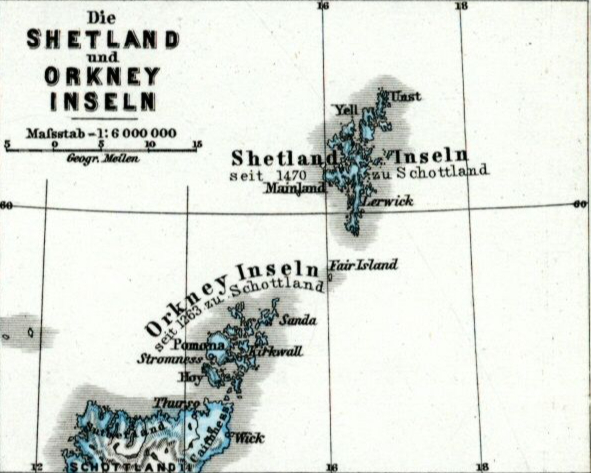mobile View, to the German Version tap the flag


- Scottish Unitary Authority (Council Area) and Lord-Lieutenancy
- own names:
– English: Shetland
– Scottish Gaelic: Sealtainn
– Old Norse: Hjaltland
• Flag
• Meaning/Origin of the Flag
• Coat of Arms
• Meaning/Origin of the Coat of Arms
• Map
• Numbers and Facts
• History
• Origin of the Country's Name

since 2005,
Flag of the Shetland Islands
ratio = 3:5,
Source, by:
Wikipedia (DE)






Shetland is an island group in the North Sea miles from Scotland's north-east coast.
Its inhabitants, like Orcadians, (→ Orkney Islands),
are of Norse descent. A Norse dialect, called Norn, was spoken here until the late 19th century. This flag was
devised by students as an unofficial in 1969 and reflects Shetland's Scandinavian
ancestry by the colours of Scotland. In 2005 the flag was officially recognized by the Scottish Heraldry Bureau.
Source: Stateless Nations, Wikipedia (DE)


Coat of arms of the Shetland Islands,
Source, by:
Wikipedia (EN)

"The blue shield with a Viking warship at sea recalls the old link with the Nordic countries and Shetland's reliance on the sea. The blue and gold colours were taken from the old Earldom of Orkney, as the Shetland islands belonged to this Earldom during the Norse era."
Source, citation: internetbusinessdirectory.co.uk

Location:

Source: Freeware, University of Texas Libraries, modyfied by: Volker Preuß
Map of the Orkney and Shetland Islands:

Source: Hand-Atlas für die Geschichte des Mittelalters und die neueren Zeit, von Spruner und Menke

Area: 566 square miles
Inhabitants: 23.210 (2018)
Density of Population: 41 inh./sq.mi.
Capital: Lerwick, 6.958 inh. (2011)
official Language: English
other Languages: Scottish Gaelic, Scots (Lallans)
Time Zone: Greenwich Meantime = CET – 1 h
Source:
Wikipedia (DE)

ca. 400 B.C. · immigration of Celtic tribes onto the islands
ca. 700–800 · Normans capture the Orkney Islands and they become a Norwegian county
995 · beginning conversion to Christianity
1468 · Christian I., king of Denmark and Norway, pledges the Orkney and the Shetland Islands for the dowry of his daughter Margaret, as assurance for the marriage with James III. king of Scotland
1472 · the pledge gets redeemed, Scotland annexes the islands
1611 · the Danish law gets abolished
Source:
Atlas zur Geschichte,
Discovery '97,
Wikipedia (DE)

The origin of the islands' name is largely obscure, but there is one theory: the first written mention of the islands was in early Irish literature as "Insi Catt", meaning an "Isle of Cat" inhabited by the Pictish Cat people. Such a people actually lived in the north of Scotland. When the Norwegians came and spread to the islands with their Old Norse language (Norn), they called the islands "Hjaltland". An "Hjalt" is a stabbing weapon. As the Norn was gradually displaced by the Gaelic Scots language and also writing, "Hjaltland" became "Hetland" and was written with the Scots letter "yogh" at the beginning, and probably pronounced that way. It looks quite similar to the number 3. When the letter "yogh" was no longer used, it was replaced in the spelling by "Z", because the Z looks quite similar to the 3 in old scripts. This is how "Zetland" came into being, sporadically written this way until 1975, which later became "Shetland".
Source: Wikipedia (EN)


![]()







